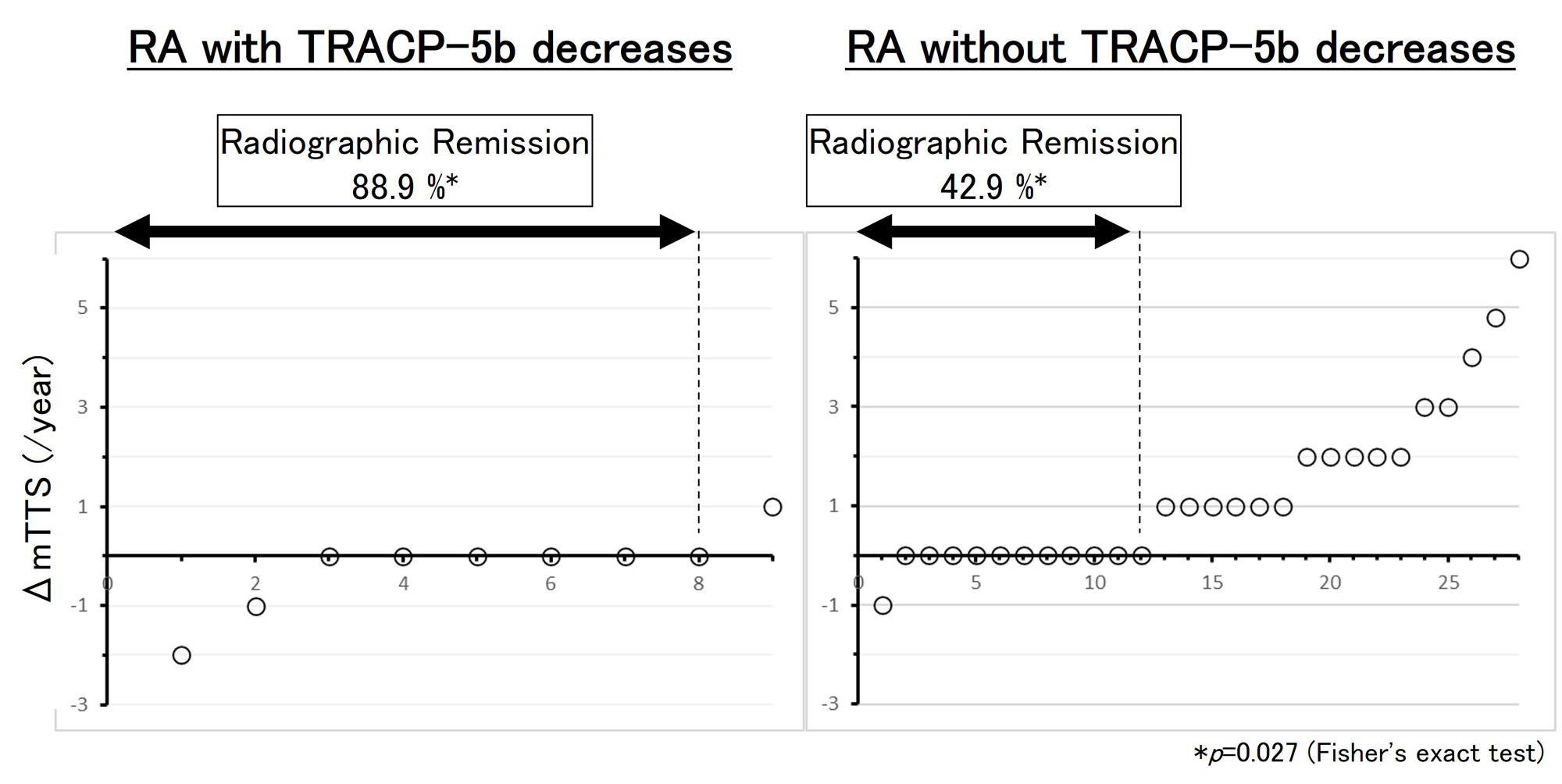Session Information
Date: Monday, November 13, 2023
Title: (1264–1307) RA – Diagnosis, Manifestations, and Outcomes Poster II
Session Type: Poster Session B
Session Time: 9:00AM-11:00AM
Background/Purpose: Rheumatoid Arthritis (RA) is one of inflammatory arthritis, and this autoimmune-mediated polyarthritis results in structural joint destruction. Articular bone erosion leading to joint destruction in RA is caused by bone resorption of osteoclasts activated by synovial inflammation. Joint damage is usually evaluated by imaging studies, but there are few reports in which joint damage was assessed by bone resorption markers that reflect osteoclast activity. Tartrate-resistant acid phosphatase (TRACP) 5b is a bone resorption marker localized only in osteoclasts and is released during bone resorption, so it directly reflects the number and active state of osteoclasts. Recently, serum levels of TRACP-5b have been reported to correlate with the severity of radiographic damage and the number of articular bone erosion of computed tomography in RA patients. However, the relationship between TRACP-5b and joint damage progression is still unclear. Therefore, we investigated whether TRACP-5b is useful for evaluating the progression of articular damage in RA.
Methods: 37 RA patients were registered, who filled RA criteria 2010, were premenopausal women and men younger than 55 years at enrollment (M0), didn’t have metabolic bone diseases or malignancies, were in the treatment with DMARDs, and were followed up until month 12 (M12). Serum TRACP-5b level measurement and radiographic joint damage assessment were performed at M0 and M12. A significant decrease in TRACP-5b titers was defined as a decrease of 12.4% (the minimum significant change; MSC) or more in one year. Radiographic remission of join damage was defined as yearly modified total Sharp score (mTSS) progression below 0.5. Their medical records were reviewed retrospectively.
Results: Subjects at M0 were 31 female, were median age 45.7 years with 5.4 years of disease duration, and were treated with MTX, glucocorticoid, biological/targeted synthetic DMARD and bisphosphonate/denosumab (n=30, 9, 12 and 6, respectively). RA disease activity of median SDAI was 3.29 at M0 and 4.09 at M12 (p=0.670), and median mTSS changed from 15 to 14 (p=0.027). Serum TRACP-5b titers (median) were 253 mU/dl at M0 and 294 at M12 (p=0.672). TRACP-5b levels at M0 and M12 didn’t correlated with mTSS at M0 and M12. Increases in TRACP-5b titers between M0 and M12 were positively correlated with changes in erosion score of mTSS (ρ=0.5166; p=0.0011). 20 of 37 subjects (54.1%) achieved remission in radiographic evaluation. In univariate analysis, increases in TRACP-5b titers were negatively associated with radiographic remission (OR=0.980; 95% confidence interval: 0.961-0.993, for each 1 mU/dl increase in TRACP-5b titers; p=0.001). Only 9 of 37 patients showed significant decreases in TRACP-5b titers. 8 of these 9 patients (88.9%) had radiographic remission, but only 42.9 % of 28 cases without TRACP-5b decreases showed structural remission (p=0.027).
Conclusion: Changes in serum TRACP-5b levels were related to aggravation of joint damage in RA during treatment. TRACP-5b is useful for assessing progression of RA joint destruction. In the absence of significant TRACP-5b reduction, joint damage progresses in about 60 % of RA patients.
To cite this abstract in AMA style:
Owada T, Kobayashi T, Tanaka A, Ikeda K, Hirata H, Arima M, Kurasawa K, Fukushima Y. Increases in Serum Levels of Tartrate-Resistant Acid Phosphatase 5b Reflected Radiographic Progression of Joint Damage in Treated Rheumatoid Arthritis [abstract]. Arthritis Rheumatol. 2023; 75 (suppl 9). https://acrabstracts.org/abstract/increases-in-serum-levels-of-tartrate-resistant-acid-phosphatase-5b-reflected-radiographic-progression-of-joint-damage-in-treated-rheumatoid-arthritis/. Accessed .« Back to ACR Convergence 2023
ACR Meeting Abstracts - https://acrabstracts.org/abstract/increases-in-serum-levels-of-tartrate-resistant-acid-phosphatase-5b-reflected-radiographic-progression-of-joint-damage-in-treated-rheumatoid-arthritis/

